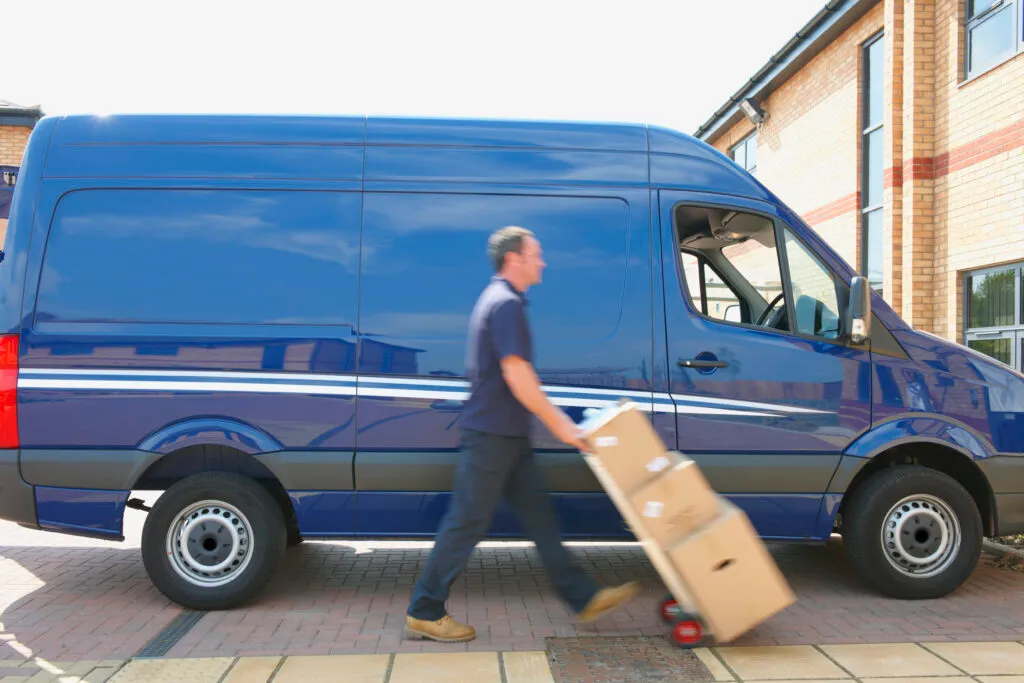
Get home early with RoadWarrior.
Enter your stops, optimize your routes, manage your team – quickly and efficiently.
Try RoadWarrior free for 7 days
Try free for 7 daysAs winter rolls in and road conditions worsen across the country, most people prefer to curl up under a blanket and avoid driving if they can. For the drivers on “Ice Road Truckers,” however, icy conditions mean big money. The History Channel television show follows these weather savvy drivers as they carry multiton truckloads across dangerous stretches of frozen lakes in Alaska and Canada, braving brutal weather and sleep deprivation in the process. While the drivers on the show have traveling on ice down to a science, most people have a harder time handling slick winter roads. In fact, icy roads contributed to nearly 500 U.S. fatalities in the winter of 2008-2009 alone [source: IcyRoadSafety.com].
Icy roads aren’t just a problem in the northernmost states either. Midwestern and southern states only get snow a few times a year, but transportation departments in those states are less equipped to respond to icy road conditions. Since drivers in those states have less experience and preparation for winter driving, they find themselves at a high risk of getting in an accident whenever winter weather affects the roads. In fact, icy roads caused more fatalities in Indiana than any other state for the 2008-09 winter season, with states like Oklahoma and Texas also in the top 10 [source: IcyRoadSafety.com].
Fortunately, there are a number of different ways you can prepare yourself and your car to help safely navigate icy roads. In this article, we’ll take a look at what makes driving on ice so dangerous, along with ways you can stay safe when road conditions take a turn for the worse. Read on to learn how to drive on ice and good tires can help you get a grip on winter driving.
Ice Traction
No matter how safely you drive, you won’t get very far without good traction, and good traction starts with good tires. At a minimum, make sure your tires are properly inflated and have plenty of tread left on them before you drive on icy roads.
If you’ll be spending significant time driving on ice, you’ll likely need to switch to snow tires every winter. Snow tires are made of softer rubber than all-weather tires, which gives them a better grip on the road. In addition, snow tires have specially designed tread patterns to provide better traction on ice and snow. Some snow tires even have the ability to accept metal “studs” for additional traction in certain situations, although these studs are banned in some areas since they damage roads. Snow tires will wear out quickly in normal driving conditions because they’re made of softer rubber, so make sure to switch back to all-weather tires once winter has passed.
Snow chains are another way to get better traction on icy roads, and since you can keep a set in your car at all times, they can be a lifesaver if you find yourself caught in a snowstorm. With snow chains, however, you won’t be able to drive faster than around 30 miles per hour (48 kilometers per hour).
Lastly, cars with four-wheel drive (4WD) can hug icy roads better than those with two-wheel drive, though even 4WD cars will need snow tires or chains to handle more extreme winter weather.
Even with a properly equipped car, driving on icy roads is still a dangerous proposition, which is why states invest millions of dollars in plowing streets and highways, as well as covering them with salt and sand. Salt and sand are often used together to improve road conditions since they each provide a different function in improving traction. Salt dissolves into icy roads and actually lowers the freezing temperature of ice, while sand provides a gritty surface for tires to adhere to.
Salt Prices Lead to Slippery Roads
At $59 per ton, salt prices in 2009 are more than 20 percent higher than they were a year ago. As a result, many U.S. counties are having to cut back their efforts to keep salt on the streets. In some cases, transportation departments are forced to concentrate on de-icing areas like curves and bridges rather than entire roads, a situation they recognize as less than ideal. Some residents can expect slower response times as well, since budget shortfalls have kept road crews short-staffed [source: Piazza].
Reducing Driving Speed on Ice
Speed can be dangerous regardless of the driving conditions. In fact, speeding was a factor in more than 13,000 fatal crashes in 2006, contributing to an estimated $40 billion in crash-related expenses for the U.S. government [source: ACEP]. As you might imagine, then, speed and ice are a bad combination. On slick roads, even driving the speed limit can put you at risk of getting in an accident or getting a ticket, which explains why traffic typically slows to anywhere from 5 to 40 percent of its average speed in heavy snowstorms [source: U.S. DOT].
Speed makes you more likely to get in a wreck for a couple of reasons. At higher speeds, you won’t have as much time to react if someone brakes ahead of you, and since it takes twice as long to stop on icy roads, you can easily find yourself in a fender bender. You also have less control over your car at higher speeds, particularly in bad weather.
Ironically, slowing down on icy roads can be dangerous as well. That’s because braking on ice can easily put your car into a spin if not done properly. If your car has an anti-lock braking system (ABS), you should maintain a steady pressure on the brake pedal; your car’s ABS will handle the braking for you and adapt to the road conditions. When your car engages its ABS, you’ll feel a pulsing in the brake pedal. The pulsing results from the ABS applying and disengaging the car’s brakes, so make sure not to take your foot off the brake once you feel the system engage.
If your car doesn’t have ABS, you’ll likely need to pump your brakes to avoid sending your car into a skid. If you do start to skid, remain calm and steer gently into the skid until your tires regain traction, and make sure not to press the brake until you’ve re-established control.
Read on to learn about one of the hidden threats of driving in freezing temperatures.
Driving on Black Ice
If you want to get technical, black ice should really be called “clear ice.” Because black ice forms with very few air bubbles, it’s virtually transparent and much harder to see than normal ice. Drivers usually mistake black ice for wet pavement, so they’re often totally unprepared to react to the slippery conditions. One study found that driving on black ice was five times more dangerous than driving in normal conditions. Stopping on black ice takes nine times longer than normal [source: Adams]. Studded tires and snow chains can help you stop faster, but not by much.
Making matters worse, black ice can form when you least expect it. A snowfall may have melted days before, but the roads can still have patches of black ice waiting to send your car out of control. Black ice is more likely to cause problems in the mornings and at night when temperatures drop.
You should be particularly wary of driving over bridges and overpasses once freezing winter temperatures kick in, but black ice also can form on shaded sections of the road. Besides driving slowly and carefully, there’s not much else you can do when you find yourself on black ice. If you’re fortunate, the highway department will have treated the roads with salt or sand, but even then your car’s stopping distance and handling will be impaired.
An Ounce of (Ice) Prevention
In certain parts of Minnesota, the state has installed an automated anti-icing system that automatically springs into action whenever conditions are right for black ice formation. The system consists of a tank to hold an anti-icing solution, along with nozzles embedded in the pavement and sensors that read weather conditions. Because the system prevents ice from adhering to the roads, it buys road crews time to further treat roads and keep drivers safe [source: Minnesota DOT].
Tips for Driving on Ice
The first step to becoming a safe driver in icy conditions starts before you put the key in the ignition. By checking and maintaining your car’s safety systems, you can make sure you won’t be caught unprepared once you hit the roads. Make sure your windshield wipers are functioning, and don’t forget to check the level of your wiper fluid in the process. Test your front and rear defrosters as well; impaired visibility is the last thing you want when driving on ice. If your car’s battery hasn’t been replaced in years, you should consider getting a new one. Top off your antifreeze as well. If you’re running low, you can damage your car’s cooling system. Lastly, don’t let the gas tank get below half empty in the winter.
After you’ve checked to make sure your car is in great running condition, take the time to stock up on some items that can prove useful in an emergency. Pack your car with items like jumper cables, an ice scraper, an emergency kit, a flashlight and fuel line de-icer. Sand or cat litter can be a lifesaver if you get stuck on icy roads. You may want to keep a bag of one or the other in your trunk during the winter and pour it under your tires to get some much-needed traction. Also consider keeping some blankets and snacks in your car in case you find yourself stranded for a little while. You don’t want to add “cold” and “hungry” to your list of problems.
Once you’ve prepared your car for winter weather, keep these driving tips in mind to make your journey go smoothly. Use your car’s lower gears on icy roads, particularly when you’re going up hills. In addition, don’t engage cruise control or overdrive on your car, since you’ll be sacrificing control in the process.
If you do find yourself skidding on ice, don’t make any drastic corrections or slam on the brakes. Instead, as we just discussed, gently steer into the direction of the skid and apply the gas once you’ve regained traction. If you’re stuck, don’t floor the gas in an attempt to power out of ice or snow; you’ll only dig yourself deeper in the process. Instead, place cardboard, cat litter, sand or even your car’s floor mats under the car’s wheels and try to gently pull out of the slippery area. With a little patience, you should be back on your way in no time.
Content written by Jonathan Atteberry and created in partnership with HowStuffWorks.com


